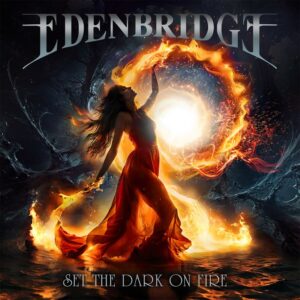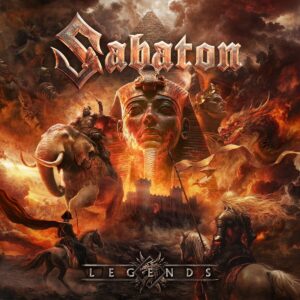Codex Omega
Septicflesh
•
August 28, 2017

I feel confident in saying that I am not alone in saying that most, if not all, metal heads love some form of grandiose in their metal, or that metal in and of itself contains a sense of grandiose in its composure that draws us towards it. Monstrous solos and eviscerating riffs, complexity in the music and often deeper lyricism, metal as a whole tends to have something deeper, a sense of being larger than life. When it comes to this sensation, it is hard to convey it better than through the sub-genre that is Symphonic Death Metal, with the bloody brilliance of death metal and the absolute beauty of an orchestra to weave these 2 elements together into a masterful sound. When it comes to this subgenre of metal, SEPTICFLESH are widely revered as being one of the best and undoubtedly one of the most established names. This status is likely to only go further with the release of their newest, and arguably best, album "Codex Omega." This feat is all the more impressive when one realizes it is the first release with their newest drummer Krimh, the album as a whole flowing as if he had been a long time member of the titans of Symphonic Death Metal.
I will preface this section by saying it is incredibly difficult to decide upon which songs to write about as all of them are great and many are brilliant with their well-placed use of choirs, orchestras, arpeggios, concertos, and the like. However, to start I shall begin with "Third Testament (Codex Omega)", for its style that is fairly different from the average SEPTICFLESH. To begin with, there is some aspect of the drums, a sort of domineering sound that is ever so slightly more noticeable than previous songs, as well as a style to the guitars that that is also more dominant than was is the average compared to the orchestrals (of which take a backseat in this song). As well riffs that seems to be grittier, it is somewhat more odd than the average SF song, though not overly so. Still a great song with a strong atmosphere, just different.
Following this up is "Portrait of a Headless Man", and though it returns to a more recognizable style for the band, though saying this is hardly helpful as their style spans so widely. Regardless, the orchestral and metal aspects flow together seamlessly and brilliantly between head banging brutality and atmospheric and graceful beauty. That is the key aspect of symphonic death metal, and though SEPTICFLESH has done this countless times in the past they have reached a point of perfect balance, displaying a stark beauty in their creation that surpasses all previous creations of theirs. Back to the song itself, it is a piece of beauty between the balance of orchestra and death metal and the graceful choir vocals. Throughout they maintain an incredible sense of intense foreboding and regret, which is perfect for the song when the lyrics come to light (the song is largely about a man with great regret over misdeeds and following false prophets and corrupt leaders). The song builds up to the climax of orchestration and melody that closes off the song perfectly.
Next we come to "Dark Art", the opening of which is far more somber than the usual eerie opening we have come to expect. The song is rather ironic in its naming as it is likely the most upbeat song on the album in its chorus. The style and tempo in which the chorus comes is a very refreshing one, and while there have been upbeat choruses and sounds before none come so far as this one. It is a nice change to hear something that borders radically different in their use of orchestration. This sense of an upbeat tempo is almost present throughout but most clearly demonstrates itself in the choruses. This change of style does not in the slightest affect the brilliance that one can come to expect from this album however, and only goes on to create a hope of a wider variety of styles of symphonic death metal from SEPTICFLESH.
Following this is "Our Church, Below the Sea", a song that seems that it may as well have had its lyrics come straight from the Call of Cthulhu. This fact, however, is one I take solace in. SEPTICFLESH has before made direct and some indirect references to the father of Cosmic Horror HP Lovecraft himself (the most obvious of which is "Lovecraft's Death" from the album "Communion"). I may well be wrong, yet there are several lines suggesting a strong correlation between the two. As for the song's style itself, it leans towards more traditional death metal a fair bit again, especially with its opening and verses. Yet underlying it all is a sound that reminds one of a sickly corrupt religion. Ideas such as pianist organs and a sick corruption. This is conveyed subtly throughout the song yet it is an idea that constantly gnaws at the back of one's mind throughout its entirety. Finally I will close with "Faceless Queen", which is almost dichotomic in its sound. While a somewhat common theme in songs is a more metal esque verse and orchestral chorus, this song take it almost to an extreme. Admittedly the verses' riffs are somewhat bland, either a tiny bit basic or using a familiar refrain from many other songs. However, the choruses do not fail to deliver, and the song's latter half creates a phenomenal atmosphere with a rising sensation that ends abruptly in a sense of perversion ushered in by someone else's harsh vocals (admittedly I did not know who it was as it did not sound like Siro Antoniou's vocals). Again, though perhaps the verses were a tad bit bland, the song as a whole was phenomenal.
There were a number of songs I wanted to cover, like "Enemy of Truth", but I deemed it to be unnecessary as they were released as singles already. Despite this it was incredibly hard to decide which songs to cover as all were brilliant in a number of ways and a fair few were utterly phenomenal. I am also thoroughly impressed with the seemingly seamless transition of Krimh into the folds of SEPTICFLESH and wish to congratulate him on a job well done, as well wish him good luck with these behemoths of Symphonic Death metal. I highly recommend this album to most anyone, and also encourage others to read deeply into the lyrics. One thing I did not mention earlier but that might be noticed is the fact there seems to be multiple key figures mentioned throughout the album, as if there is a far more connected overarching theme. Titan heavily featured the concept of striving to reach too high to the heavens and finding ruination as a result and featured some figures like a metaphorical Icarus and the literal Prometheus, but the idea of key figures is taken further here in Codex Omega. Figures such as the faceless queen, the martyr, several references to an architect (though this one is a reach), the enemy of truth, and the headless man to quote a few. This might be nonsensical ramblings and looking too heavily into it, yet with the often layered and intense meaning behind the lyrics of SEPTICFLESH I would not be surprised if there was an overarching connection. It is here I bid that everyone who can listen to this magnificent album.
10 / 10
Masterpiece
Songwriting
Musicianship
Memorability
Production

"Codex Omega" Track-listing:
Disc 1:
1. Dante's Inferno
2. 3rd Testament (Codex Omega)
3. Portrait of a Headless Man
4. Martyr
5. Enemy of Truth
6. Dark Art
7. Our Church, Below the Sea
8. Faceless Queen
9. Gospels of Fear
10. Trinity
Disc 2 (Orchestral Disc):
1. Martyr of Truth
2. Dark Testament
3. Portrait of a Headless Man
Septicflesh Lineup:
Spiros "Seth" Antoniou - Lead Vocals, Bass
Christos Antoniou - Guitars, Orchestration
Sotiris Vayenas - Guitar, Clean Vocals
Kerim "Krimh" Lechner - Drums
More results...





















